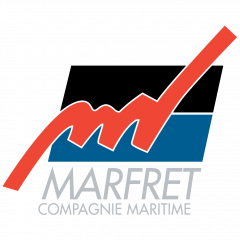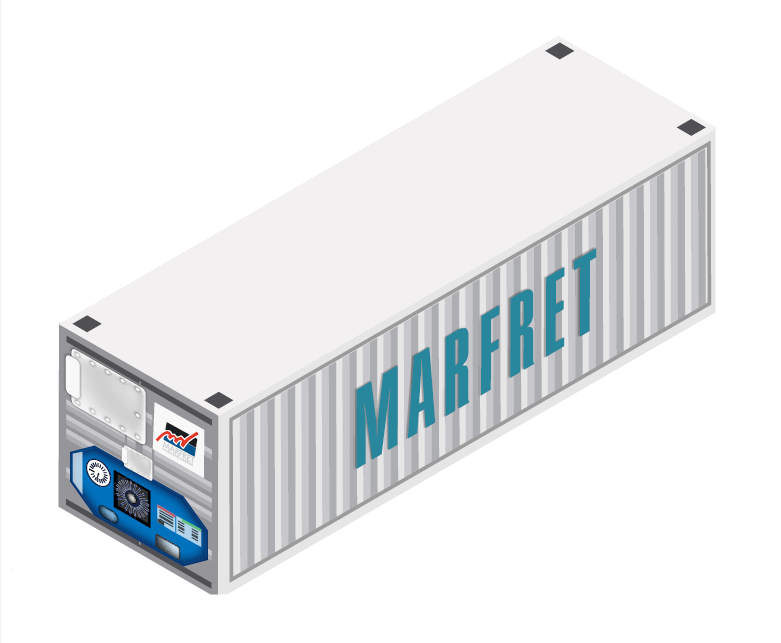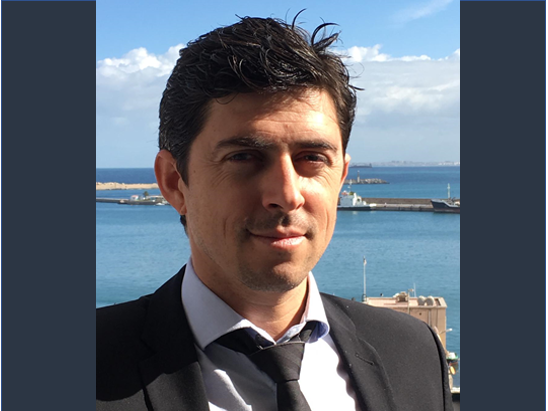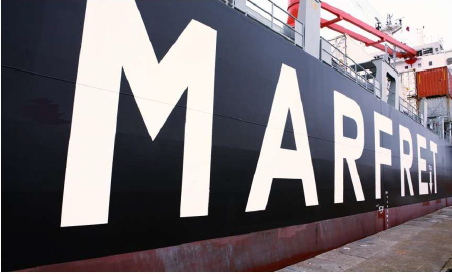To ensure the fruits remain in optimum shape during the sea crossing, in January, 2018, Marfret invested in a fleet of 250 brand-new 40′ high-cube refrigerated containers. The containers, which provide a controlled atmosphere thanks to Starcool technology, have become an immediate hit with producers of avocados, the tender flesh of which is especially fragile.
Three questions to Guillaume Vidil, Managing Director of Marfret
At the age of 37, Guillaume Vidil, Managing Director of Fluviofeeder Armement, takes over the general management of Marfret.
The legal reorganization of the company was completed in May 2018, the date of Marfret’s General Meeting (AGM). Marfret became a SAS with a Supervisory Board in which Marseille Fret is the president and Guillaume Vidil the general manager.
You have been managing Marfret since May 2018. Have you been prepared since childhood to succeed your grandfather, father and uncle?
As a child, I dreamed of becoming an oceanographer and travelling the world to discover the oceans. It was implicit that I would one day take over the reins of the company and my grandfather was clearly keen for me to do so. During my high school years, I would have lunch with him every Tuesday and he would always ask me when I would take over the company! It was a kind of joke between us. Once I had the baccalaureate in my pocket, I passed the competition to get into the Ecole Nationale de la Marine Marchande. My first voyage as a student deck and engine officer was aboard an oceanographic research vessel for Genavir.
I then joined Marseille Fret as a junior officer, then as chief officer and as second engineer on container ships. After two years at sea, the Marfret newbuilds required monitoring at the Ulsan Shipyard in Ulsan, Korea. I participated in the delivery of the Marfret Guyana and Marajo and their maiden voyages before finally taking a break in 2009 after the naming ceremony of the Marfret Marajo. In my break year I travelled a lot. That’s when I became fully aware of my growing desire to join the family business. I had to give myself the means, serve my time, climb all the ladders and properly learn the business from the bottom up in order to become a fully legitimate business leader and not be considered to have reached such a position of authority only because I was “the son of”.
How has your career evolved at Marfret?
It started ashore in river transport as superintendent of the Fluviofeeder Armement (FFA) subsidiary. Since Genevilliers, I was in charge of the technical maintenance of the fleet of container barges. It was the discovery of the world of inland navigation. In 2011, I became branch manager and, a year later, I was director of Fluviofeeder Armament. In 2015, I retained my position as Managing Director of FFA whilst becoming Head of the Mediterranean Caribbean line.
My technical curriculum has been extended to include management training. Within IAE school, I discovered marketing, accounting, suppliers and customers! I am a member of the Association for the Progress of Management (APM), a club that brings together business leaders. But I consider that my training is not finished.
What is your vision for the future of the Marfret Group?
To organize the group’s development whilst also diversifying it. We are at the same time shipowners, freight forwarders, stevedores and shipping agents. For several months now, Marfret has been offering logistics and warehousing services as well. We have just experienced a business cycle marked by major mergers in maritime transport and the arrival of mega container ships. Many medium-sized companies have disappeared. Raymond and Bernard Vidil form a fantastic duo. Together they have been able to resist the anti-competitive trend of liner agglomeration and defend our company’s market positioning. I am taking up my new position at a time when Marfret is considering a redeployment both geographically and in terms of diversification into new businesses. I firmly believe in our teams’ capacity for innovation all the while remaining faithful to the company’s DNA, namely our proximity to, our listening to and understanding of and our availability to our customers.
Global Sulfur Cap, the time of choice
As of 1 January 2020, all merchant ships will have to reduce their sulphur emissions from 3.5% to 0.5%. Shipowners and oil majors are moving to fulfil the demand and to meet the technological and economic challenges introduced by the International Maritime Organization’s (IMO) sulphur regulations.
Faced with uncertainties about the quantities which will be available and the price of low-sulphur HFO, companies are coming to a crossroads. From July 2019, they will have to make choices that will commit them to new long-term fuel strategies. Whether the answer is diesel, LNG or internal scrubber technology, one thing seems certain: these new regulations will substantially increase the cost of maritime transport. Beyond the impact on shipping lines, manufacturers and raw materials producers in source countries may also suffer. Under the guise of the environment, it is the very principles of the globalized economy that industrials will have to rethink.
The countdown is on. With just eleven months to go before this crucial deadline for the maritime transport industry, the time to make a choice is fast approaching. However, before ship owners can reach a decision that will bring them into compliance, they have to navigate through the fog of uncertainty which lies around costs and availability of compliant fuels. They must meet at all costs the challenge of the maximum 0.5% cap on sulphur emissions which is scheduled scheduled for 1 January 2020. No obligation has been issued by the International Maritime Organization to oil producers and refineries to produce low sulphur fuel in sufficient quantities, and of acceptable quality, to serve the industry. Moreover, the signatory states do not feel responsible for the result. What will become of the quantities of HFO with Sulphur content of 3.5% which is produced in abundance by refineries and which nobody will then want? Tomorrow, will they be able to compensate with Marine Gas Oil (MGO), which, it would seem, is most likely to become the dominant fuel?
This is a worrying situation. In effect shipowners have three options available to bring them into compliance:
- continue to consume 3.5% fuel oil and equip or retro-fit ships with scrubbers.
- Change fuel and refuel either with 0.5% fuel (if sufficient quantities can be made available) or switch to diesel.
- Finally, the most radical solution is to change engine propulsion technology to LNG, hydrogen or hybrid ships.
To date, of the 55,000 merchant ships in operation, very few have invested in scrubbers or new propulsion technologies. Eleven months to convert the world fleet seems unrealistic. Nothing at this stage can change or improve this situation any faster.
The equation to be solved has two major unknowns: the price and availability of each fuel type.
Revision of charter parties
For several months, Marfret’s technical services have been preparing for this deadline. “In the first quarter of 2019, we will choose the fuel according to the navigation zones and product availability… From February to September, we will prepare the fleet, adapt the ship’s fuel system, if necessary according to the specifications of the available product and draft new bunker procedures. By 1 October at the latest, we will start bunkering with 0.5% fuel oil or MGO, after rinsing the tanks,” explains the arms captain Charles Gauthier. To be in compliance we will have to ensure that we have burned all of the 3.5% Sulphur HFO. “The situation is different when the ship is chartered (Nasp, MedCar),” adds Charles Gauthier.
As regards chartering, the new IMO rules require a revision of the charter party and a redefinition of the broker’s strategy. Should it look for ships equipped with scrubbers or which will be capable of consuming the available fuel, depending on the case, diesel or 0.5% fuel oil?
Operators will have to be vigilant about the quality of the product available. In the absence of a precise framework, two types of 0.5% HFO will be on the market. The first, produced by refineries that will have made the $1 billion investment on time, is more likely to be of quality, the second, is likely to be more unstable because it will be produced from mixing with diesel fuel and various additives and it could cause damage to the vessel’s engines.
These choices will affect the financial equilibrium of the line. Fuel costs still represent 60% of the operating cost of a ship. Currently, a single day of navigation on a large container ship can cost US$80,000… What about tomorrow? The sulphur directive will drive up the price of maritime freight transport, which accounts for 90% of world trade. The new BAFs (Bunker Adjustment Factor) in preparation, which shippers are seeking to discredit, may permanently change the balance.
Many services are in danger of disappearing and many ships will be scrapped. The manufacturers who now produce in China will probably rethink their organization and relocate.
The maritime industry, which currently accounts for only 2 to 3% of global emissions, risks paying a very high price for this transition to new emission compliant fuels and technologies.



